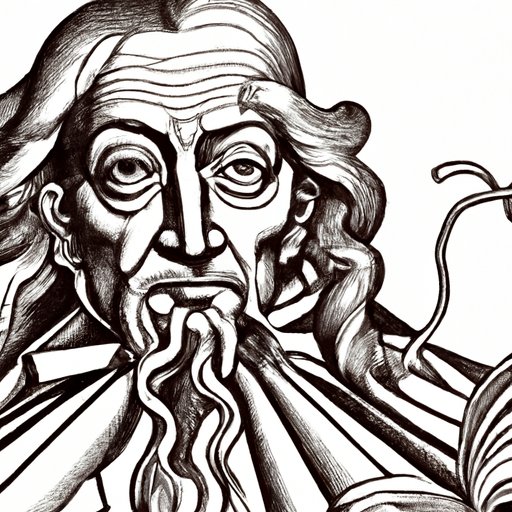
Exploring John Donne’s “A Valediction: Forbidding Mourning”: An Analysis
Introduction
For centuries, poetry has been a language of love, pain, and separation that often connects to the human experience. John Donne’s “A Valediction: Forbidding Mourning” is one such poem that captures the theme of separation between two lovers. The poem reflects Donne’s intellectual and spiritual nature, using metaphysical conceit to convey the deep bond between the speaker and his beloved, Simon. This article will explore “A Valediction: Forbidding Mourning” in detail, analyzing its poetic structure, use of metaphysical conceit, romantic elements, spiritual connotations, and historical context.
The Poetic Analysis of John Donne’s “A Valediction: Forbidding Mourning”
John Donne was an influential 16th-century poet who used his poetry to express his thoughts and ideas on love and spirituality. In “A Valediction: Forbidding Mourning,” Donne describes the separation between two lovers, allegorizing their bond to a compass. The poem comprises nine stanzas, each with a four-line rhyming pattern of abab. The poem’s formal structure creates a sense of stability, reflecting the speaker’s desire to provide comfort to his beloved during their separation.
Donne’s use of language is integral to his poetry, and “A Valediction: Forbidding Mourning” is no exception. Donne’s employment of metaphors and imagery heightens the emotional intensity of the poem.
Examining the Use of Metaphysical Conceit in “A Valediction: Forbidding Mourning”
Metaphysical conceit is a type of figurative language where an extended metaphor connects two seemingly unrelated objects. Donne’s poem makes use of the conceit of a compass to describe the relationship between the speaker and Simon. The poem compares the speaker’s beloved to the fixed point on the compass, while he is the moving leg.
The metaphor of the compass implies an unbreakable bond between the two lovers. The fixed foot of the compass represents the steadfastness, consistency, and stability of their love.
Exploring the Theme of Separation in John Donne’s “A Valediction: Forbidding Mourning”
The theme of separation is prevalent throughout the poem, as the speaker bids farewell to his beloved, insisting that mourning for the loss of their connection is unnecessary. Donne uses metaphorical images to describe the emotion of the speaker, who is separated from his beloved. The ideas of death and departure are central to the theme of separation.
Donne emphasizes the idea of separation by comparing the lovers’ bond to the connection between two compasses: “Our two souls, therefore, which are one, / Though I must go, endure not yet / A breach but an expansion.” The comparison illustrates that the bond between the speaker and Simon is so strong that it cannot be broken by anything, not even distance.
An Analysis of the Romantic Elements in “A Valediction: Forbidding Mourning”
Donne’s poem can also be understood in the context of romanticism, a movement in art and literature that originated in the late 18th century and emphasized individualism, emotion, and nature. Elements of romanticism in “A Valediction: Forbidding Mourning” include the poem’s focus on emotions, the emphasis on individualism, and the speaker’s address to a specific person.
Donne also elegantly paints the picture of their bond as “Dull sublunary lovers’ love / (Whose soul is sense) cannot admit / Of absence, ’cause it doth remove / The thing which elemented it.” His usage of romantic words like “soul,” “love,” and “absence” in the poem suggests that he embodies the concepts of romanticism in his literary works.
Understanding the Spiritual Connotations in John Donne’s “A Valediction: Forbidding Mourning”
The poem can also be interpreted spiritually, as the speaker compares the strength of their love to the connection between the soul and the body. This comparison is crucial in understanding the underlying theme of the poem. Donne’s spiritual beliefs emphasized the unity of the soul and body, and he often used metaphors based on this integration.
The poem’s spiritual connotations convey a sense of deep connection and oneness between the speaker and his beloved, reflecting Donne’s belief in the power of love to unite the body and soul. The poem implies that their connection is more profound than just being a matter of the flesh, but rather a spiritual experience.
A Critical Analysis of John Donne’s “A Valediction: Forbidding Mourning” from a Historical Perspective
John Donne lived during a time of significant upheaval in England, as the Tudor dynasty ended, and the Stuarts came to power. The theme of separation in “A Valediction: Forbidding Mourning” captures the anxieties and uncertainties of the time. Separation and loss were consistent themes in the lives of many during the time when the poem was written.
The poem’s relevance persists in contemporary society, where the theme of separation remains an essential human experience. The poem’s exploration of separation and the bonds that connect people together remain relevant today.
Conclusion
John Donne’s “A Valediction: Forbidding Mourning” is a masterpiece that perfectly captures the themes of separation, spirituality, and love. Its poetic structure, metaphysical conceit, romantic elements, spiritual connotations, and historical context all make the poem stand out as an example of the best poetry that the English language has produced. It is a poem that one can read and reread for a lifetime, as there is always something new to glean from it.
Call to Action
Read John Donne’s “A Valediction: Forbidding Mourning” and immerse yourself in this beautiful collection of stanzas. You will find a piece that has stood the test of time, and the themes explored in it will likely resonate with you deeply.





